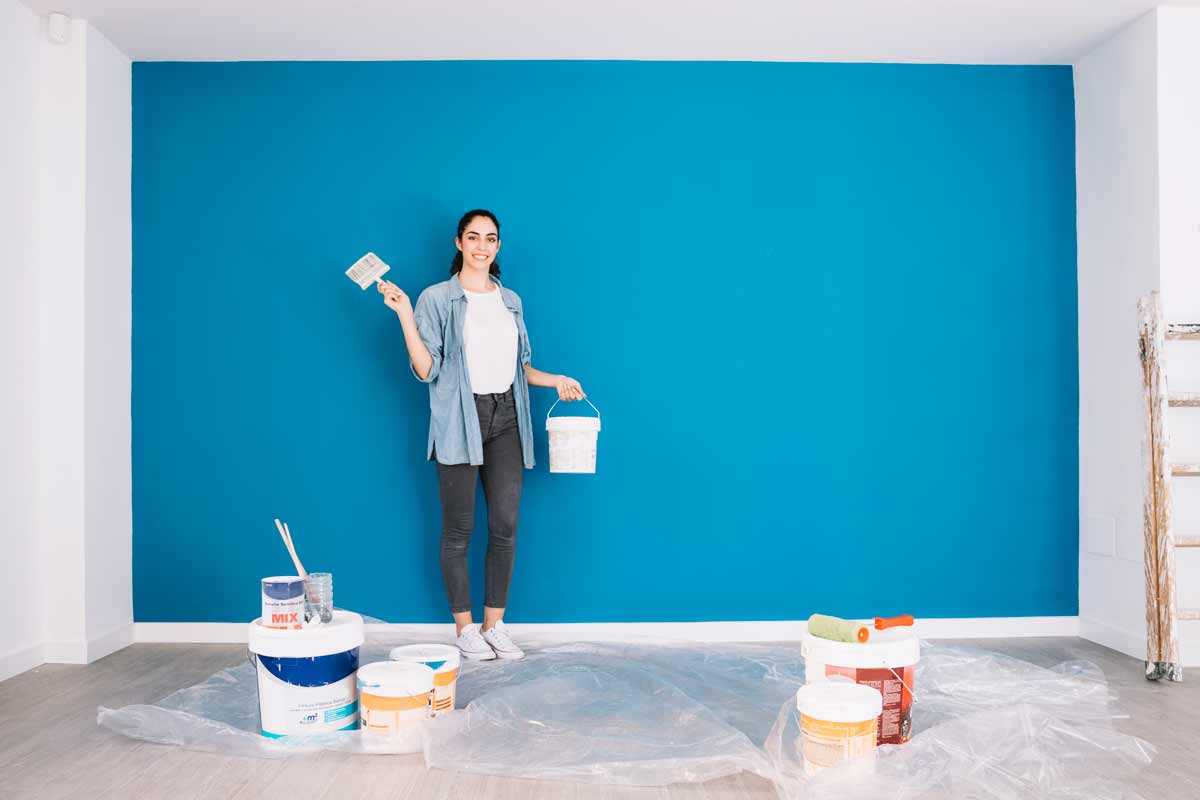Menu

✔ Before painting begins, professionals clear and protect the area by organizing the workspace, covering furniture and floors, and ensuring everything is prepped for a clean job.
✔ To ensure proper paint adhesion, they clean the surface using degreasers, mold treatments, and pressure washing for surface prep when needed.
✔ Experts inspect for damage by identifying cracks, dents, peeling paint, and moisture issues that could compromise the finish.
✔ They repair and patch imperfections with spackle, joint compound, or drywall replacement to create a solid foundation.
✔ Technicians sand the walls to smooth out repairs and feather edges, ensuring a consistent texture across the entire surface.
✔ To prepare for painting, they apply primer tailored to the wall’s condition, sealing and balancing surface absorption.
✔ Finally, a detailed final check confirms the surface is smooth, clean, and ready for paint with no overlooked flaws.
Preparing interior walls for painting is one of the most crucial stages of any remodeling or renovation project. Without proper preparation, even the highest-quality paint can fail to adhere correctly, resulting in an uneven, short-lived finish. This is where the expertise of professional surface prep teams becomes invaluable. With advanced tools and techniques, these professionals ensure your walls are in optimal condition before a single drop of paint is applied.
Here’s how surface preparation services approach wall prep with precision.
Wall preparation is the foundation that determines the overall quality, durability, and visual appeal of any paint job. Approximately 80% of coating failures are caused by inadequate surface preparation, making this step the single most critical factor in achieving long-lasting results.
Surface preparation services emphasize prep work because even the most premium paint will fail without it. With the use of advanced techniques like pressure washing for surface prep, meticulous hand-sanding, and sandblasting surface preparation, professionals eliminate guesswork and deliver flawless results.
Expert wall prep involves more than just wiping down the surface. Each phase serves a specific purpose and builds toward the ideal foundation for painting.
The first step in any professional surface prep job is organizing the workspace for safety, access, and cleanliness. This not only protects valuable items but also allows technicians to move freely and work efficiently. A properly staged area minimizes cleanup, protects valuables, and improves the overall efficiency of surface preparation services.
Wall cleaning is essential before any sanding, priming, or painting. Professionals use tailored solutions and tools to ensure every surface is free from contaminants that could interfere with paint adhesion. Each cleaning step is tailored to the surface condition and building use, ensuring a clean foundation that allows primers and paint to perform as intended.
A detailed inspection is essential before any surface smoothing or priming begins. Surface preparation services rely on precision tools to detect hidden and visible flaws that can affect paint quality.
Once all defects are identified, surface preparation services begin restoration using techniques that ensure long-lasting, seamless results.
Sanding is a critical step that ensures the surface is smooth, paint-ready, and free of texture variations.

Priming is one of the most crucial steps in professional surface prep. It seals the surface, balances absorption, and ensures that the topcoat adheres uniformly across all areas, especially where repairs were made.
The final walkthrough ensures the wall is completely paint-ready. This detailed inspection is where professional surface prep distinguishes itself from DIY jobs.
Not every project requires a DIY approach. In fact, there are numerous scenarios where surface preparation services from professional providers like Westport Professional House Painters in Westport, CT, offer the most value:
Old plaster, uneven drywall, or textured walls may require more than just sanding. In these cases, sandblasting surface preparation or mechanical leveling may be needed to reset the surface.
Mold remediation and moisture treatment require specific tools and safety protocols. Professionals can isolate the source and repair the damage while preventing future issues.
In older homes, outdated materials may pose health risks. Certified surface preparation services know how to handle and dispose of these hazards legally and safely.
If you’re painting high-end interiors or preparing a property for resale, hiring professional surface prep like Westport Professional House Painter ensures results that meet luxury standards.
Homeowners and contractors alike turn to affordable surface cleaning and prep providers to stay on schedule without sacrificing quality.
Painting an office, retail space, or multi-unit property requires coordination, speed, and quality assurance—all of which surface preparation services provide.
The surface preparation process involves cleaning, inspecting, repairing, sanding, and priming walls before painting. It ensures the surface is smooth, dry, and ready for paint to adhere properly. Professional surface prep may also include pressure washing or sandblasting for optimal results.
First, clear and protect the area, then clean the walls to remove dust and residue. Next, repair any damage, sand the surface smooth, and apply primer. Once dry, apply paint in even coats using a roller or brush, allowing proper drying time between each.
Skipping sanding can lead to poor paint adhesion, causing peeling or uneven coverage. Rough spots and repaired areas may show through the paint finish. Sanding creates a uniform texture that helps primer and paint bond effectively.
Yes, professional painters clean walls to remove grease, dust, and contaminants. This step is essential for achieving a long-lasting and smooth paint job. Cleaning methods vary, from simple wiping to pressure washing for surface prep.
Putty comes before primer in the painting process. It is used to fill holes, cracks, and imperfections to create an even surface. Once the putty is dry and sanded, primer is applied to seal the surface and prepare it for paint.
Don’t leave your next painting project to chance—trust the experienced team at Westport Professional House Painters for meticulous surface preparation and premium results. Whether you’re renovating your home or refreshing a single room, our team in Westport, CT, is equipped with the tools and expertise to get it done right. From pressure washing to sanding and priming, Westport Professional House Painters delivers superior service every step of the way.